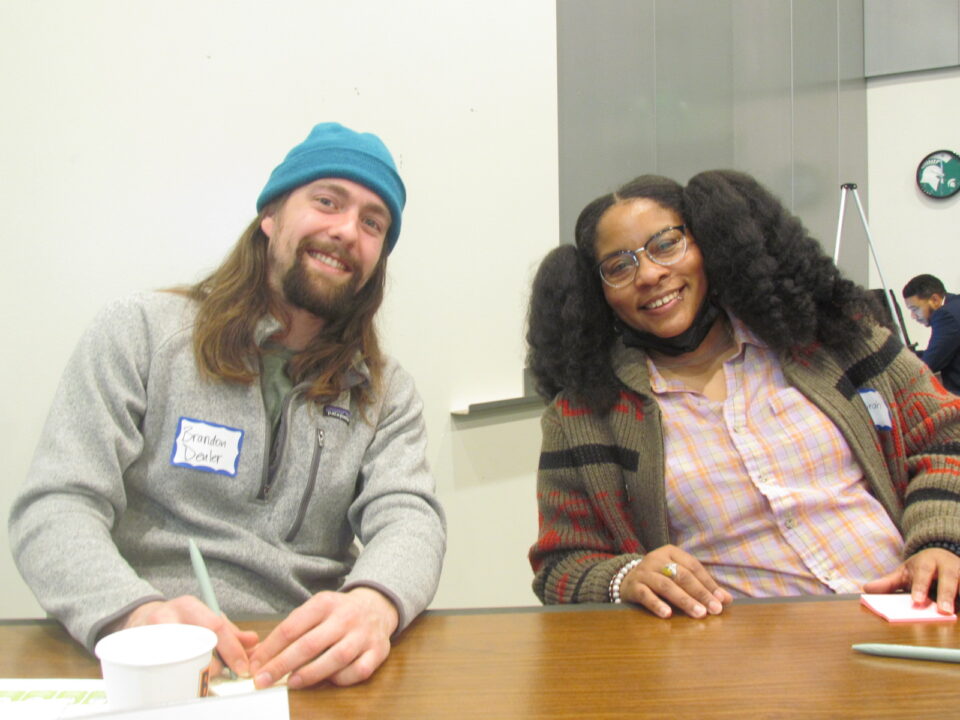Featured photo: Brandon Denler and Nayyirah Shariff were participants in a local n-person MI Healthy Climate Public Input Meeting
By Tanya Terry, with photos by Tanya Terry
EGLE recently held an in-person MI Healthy Climate Public Input Meeting in the old Flint Journal building, located at 200 E. First St., in Flint.
After icebreakers and a review of key objectives of the session, a brief overview of the MI Healthy Climate Plan (MHCP) was offered. EGLE representatives were there to talk about what MHCP aims to achieve, how it aligns with upcoming federal funding, the activities EGLE is focusing on in the near-term, and a timeline of engagement events.
Groups then chose two different topic areas related to MHCP and discussed barriers and potential solutions associated with achieving the MHCP topic area goals.
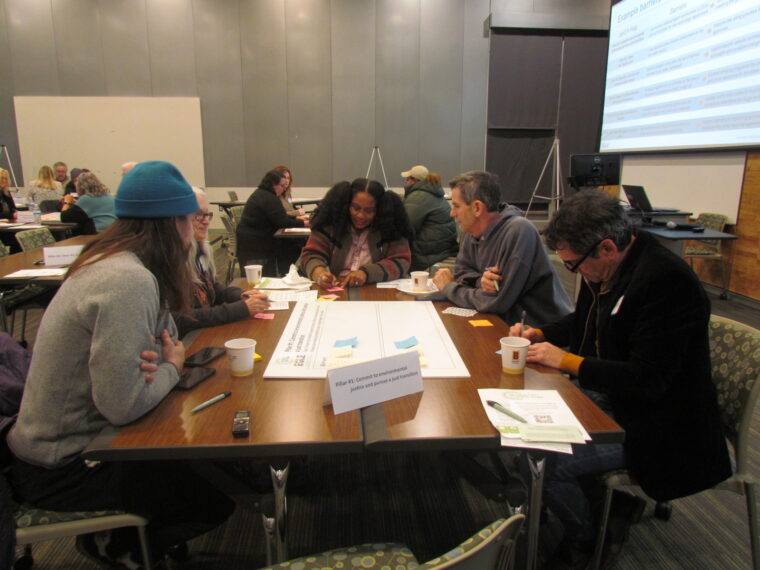
The topic areas and goals set out in the MI Healthy Climate Plan include: pillar #1: Commit to environmental justice and pursue a just transition. The goal of this pillar to ensure that at least 40% of state funding for climate-related and water infrastructure initiatives benefit Michigan’s disadvantaged communities.
Also, pillar#2 is to clean the electric grid. The goal of this pillar to achieve 60% of the state’s electricity from renewable sources and phase out coal-fired power plants by 2030.
Pillar # 3 is to electrify vehicles and increase public transit. A goal through this is to build the infrastructure necessary to support 2 million electric vehicles on Michigan roads by 2030. Another goal is to increase access to clean transportation options – including public transit – by 15% each year.
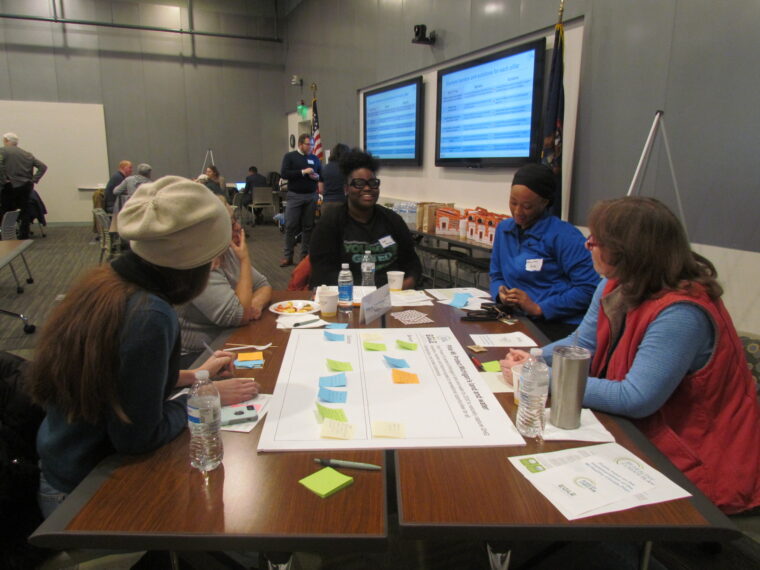
Repairing and decarbonizing homes and businesses is pillar #4. A goal of this is to reduce emissions related to heating Michigan homes and businesses by 17% by 2030. Other goals are to increase investments in repairing and improving buildings to reduce costs for working families and small businesses.
Pillar # 5 is to drive clean innovation in industry, with a goal to reduce emissions from hard-to-decarbonize industries. Another aim of this is to triple Michigan’s recycling rate to 45% and cut food waste in half by 2030.
Protecting Michigan’s land and water is pillar 6, with a goal to protect 30% of Michigan’s land and water by 2030. The purpose is to naturally capture GHG emissions, maintain and improve access to recreational opportunities for all Michiganders and protect biodiversity.
Participants in breakout group discussions created boards showcasing what they discussed in the groups. Towards the end of the program, all the participants were able to view each others’ boards and add any additional ideas they had to the boards.
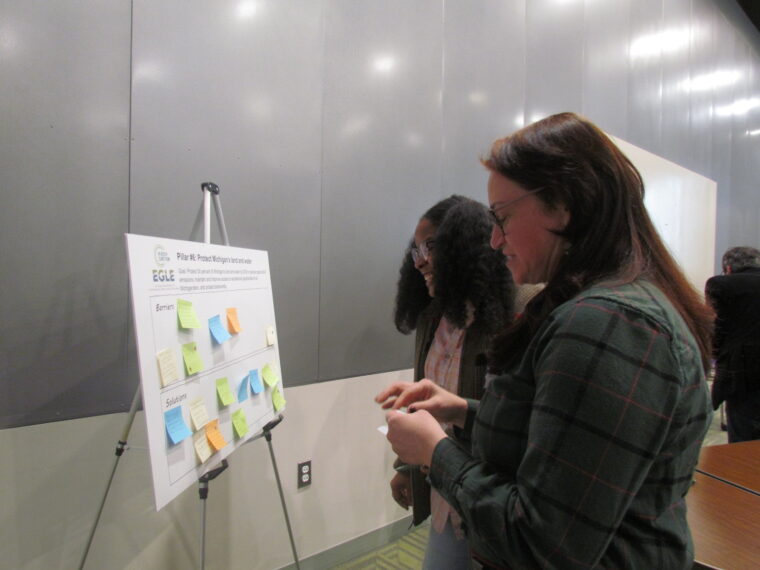
Attendees were invited to share a solution that resonated with them in front of everyone there.
First, Cory Connoly, climate and energy advisor for the Office of Climate and Energy of the state of Michigan’s Department of EGLE, asked if any of the participants wanted to talk publicly about pillar 1. The pillar involves committing to environmental justice and pursuing a just transition.
Mona Munroe-Younis from the Environmental Transformation Movement of Flint said some of the recommendations she saw that resonated with her were making information accessible to communities and residents. She said this would help environmental justice communities prepare for transition. She added part of this could be green job development, workforce development and partnerships.
Mike Buza from the Sierra Club talked about cleaning the electric grid.
“Number one, we need to do some community solar,” he said. “If we want low-income people to engage in that, we’re going to have to have community solar.”
Another participants suggested affordable options for residents include small power mills combined with wind energy products. If you have enough wind resource in your area and the situation is right, small wind electric systems are one of the most cost-effective home-based renewable energy systems — with zero emissions and pollution, according to energy.gov.
Claire McClinton of the Democracy Defense League said being from Flint, one of barriers the state was going to have is the community does not trust the state. She added that would be a hurdle for the project although the project had good goals.
“I don’t care how great the project is, if the community can’t see it, taste it and feel it, the community is going to feel left out and you’re going to have more distrust of the agency,” stated McClinton.
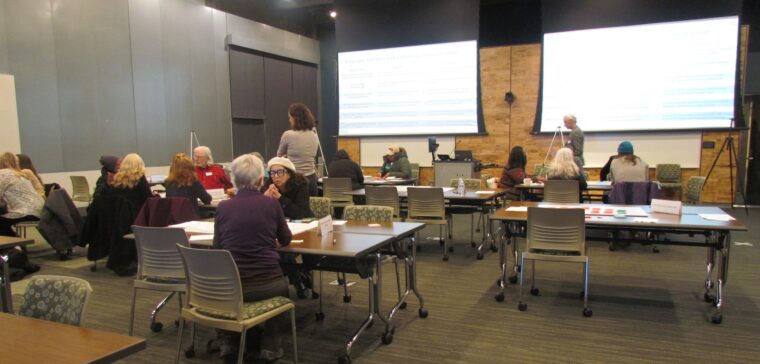
There was also a quick question and answer period, as well as a wrap-up to share resources for residents to stay involved and up to date.
Learn more about MHCP by visiting https://mhcp-egle.hub.arcgis.com/ ,by subscribing to MI Climate Action News & Updates. You can also visit the website Michigan.gov/MIHealthyClimatePlan, where you can sign up to attend the upcoming virtual listening session December 18.


